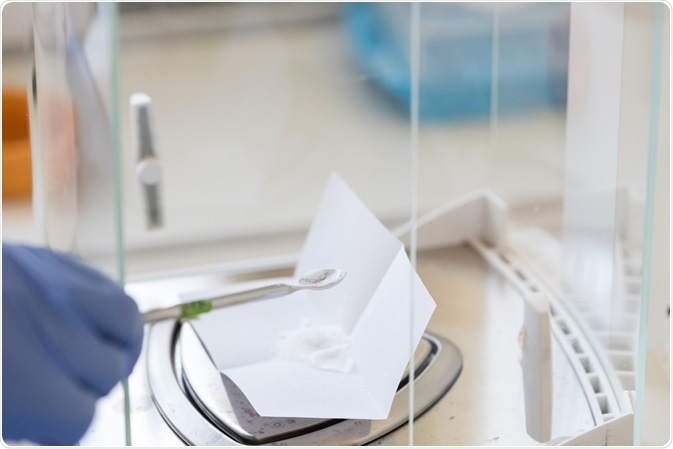How does a microbalance work?
A microbalance is a tool used in laboratories and in scientific research with the capacity to make accurate measurements of the weight of very small objects, with a resolution in the order of a millionth of a gram.
 Image Credits: daniel jack lee / Shutterstock.com
Image Credits: daniel jack lee / Shutterstock.com
The instrument is considered to be the highest precision of all kinds of lab balances. It features incredibly high sensitivity, being capable of weighing quantities from as little as 1 µg (0.000001g) up to 10.1 g. Ultra-microbalances can go even further, accurately weighing samples as small as 0.1 µg.
The tool relies on two components to function. The first is an electronic component, and the second is the precise mechanical measuring cell. The separation of these two components means that external influences, such as temperature, have no impact on the microbalance’s performance.
To use a microbalance, scientists first always put on a pair of gloves, because the residue and oils from fingers and hands have the possibility of impacting the results. Weighing an item on a microbalance is similar to how one would use a normal scale.
A container where the sample will be added is placed onto the weighing pan and the operator then tares the microbalance. The sample is then placed on the container, which is then put back on the pan.
A reading is then given regarding the weight of the sample, which is recorded. Given the extremely high sensitivity of the microbalance, users must not touch the surface it is placed on while testing, and all possible sources of vibration should be identified and prevented.
This often means keeping them away from vents, drafts, doors, and windows, as well as areas of high traffic. Areas of ambient temperatures and humidity are optimal, where air currents and dust are kept to a minimum.
There are several kinds of microbalance, the quartz crystal microbalance (QCM) is incredibly sensitive and can weigh samples of as little as 0.1 µg. They are the kind that are often used in life science experiments.
There is also the tapered element oscillating microbalance (TEOM), which is used for real-time detection of aerosol particles, as well as the quartz fiber torsion ultramicrobalance, torsion ultramicrobalance, torsion nanobalance, ultramicrobalance and the nanobalance. Finally, there is the semi-micro balance, which has a readability of 0.01mg (10µg), and is, therefore, less sensitive than the standard microbalance.
The difference between a microbalance and an analytical balance
Analytical balances are able to take precise measurements of the weight of objects, just like a microbalance can, however, the main difference is that they are 100 times less time-sensitive and also can only weigh a sample accurately to a precision of 0.1 milligrams.
While they are useful in accurately measuring the mass of a sample, their readability range is less impressive than that of a microbalance, at 0.1mg - 0.01mg. Similar to microbalances, the procedure surrounding their use focuses on preventing environmental factors influencing results, and they are therefore also kept away from drafts, and areas of high traffic, etc. These kinds of scales usually require a trained lab technician to work them and require regular calibration and maintenance.
Microbalance uses in the life sciences
The quartz crystal microbalance is the most commonly used type of microbalance in life science studies. It is more sensitive than the standard microbalance due to the piezoelectric properties of the quartz crystal.
Mass is measured based on observed changes to the resonance frequency of the crystal due to the addition of the sample. The quartz crystal microbalance, alone with other microbalances are used often in the fields of product testing and quality assurance.
They are also used within chemistry labs as well as by the mining industry for the purpose of weighing small samples of minerals and powders. The medical sector also makes use of these instruments in checking the uniformity of critical components.
Microbalances have a range of applications including pipette calibration, analysis of pesticides, particulate matter (filter) weighing, weighing chemically sensitive samples, stent weighing, ashing or incineration, measurement of coatings, drying, and checking spillage quantities.
Specifically, within the sector of life sciences, microbalances have proven their value in a range of research areas. Quartz crystal microbalances have been used successfully in the detection of pesticides in foods, using their piezoelectric properties to generate a signal at the presence of enzymes.
They have also been developed for the detection of pathogens and large molecular weight proteins, helping in the field of mycotoxins analysis. Studies have used the scales in order to measure the minute levels of contamination in order to minimize these effects.
Quartz crystal microbalances can be used to detect pathogens in food due to the changes in vibration frequency caused by the mass changes that are resultant of binding activities. Further to this, microbalances have found their use in monitoring the formation of biofilm for food and beverages.
Summary
The microbalance is an incredibly useful tool within industry and research. It can accurately measure the mass of a substance as small as 0.1 µg. Microbalances are often used in the food and beverage industries, whether that be for testing for pesticides or pathogens, or helping to control biofilm formation.
While there are several different kinds of microbalance, the quartz crystal microbalance is the most sensitive, and it has been frequently used in life science research scenarios.
Sources:
F. Gao, X. Lu. (2015) in Improving and Tailoring Enzymes for Food Quality and Functionality. Available from: www.sciencedirect.com/.../improving-and-tailoring-enzymes-for-food-quality-and-functionality
Tothill, I. (2011). Emerging bio-sensing methods for mycotoxin analysis. Determining Mycotoxins and Mycotoxigenic Fungi in Food and Feed, pp.359-384. Available from: https://www.sciencedirect.com/science/article/pii/B9781845696740500147
Pereira, A. and Melo, L. (2009). Monitoring of biofilms in the food and beverage industries. Biofilms in the Food and Beverage Industries, pp.131-151. Available from: https://www.sciencedirect.com/science/article/pii/B9781845694777500041
Farrokhzad, K., Rosenfield, C. and Applegate, B. (2015). Phage technology in high throughput screening for pathogen detection in food. High Throughput Screening for Food Safety Assessment, pp.81-121. Available from: https://www.sciencedirect.com/science/article/pii/B9780857098016000046
Further Reading